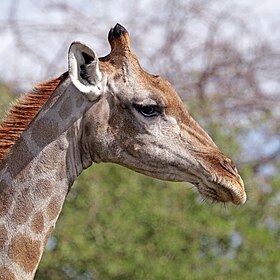| Angolan giraffe | |
|---|---|

| |
| An individual in the savannahs of Etosha National Park, Namibia. | |
| Conservation status | |
 Least Concern (IUCN 3.1) | |
| Scientific classification | |
| Domain: | Eukaryota |
| Kingdom: | Animalia |
| Phylum: | Chordata |
| Class: | Mammalia |
| Order: | Artiodactyla |
| Family: | Giraffidae |
| Genus: | Giraffa |
| Species: | G. giraffa |
| Subspecies: | G. g. angolensis |
| Trinomial name | |
| Giraffa giraffa angolensis Lydekker, 1903 | |

| |
| Range in maroon | |
The Angolan giraffe (Giraffa angolensis or Giraffa camelopardalis angolensis or Giraffa giraffa angolensis), also known as the Namibian giraffe or smokey giraffe, is a species or subspecies of giraffe that is found in northern Namibia, south-western Zambia, Botswana, western Zimbabwe and since mid-2023 again in Angola.
Taxonomy
A 2009 genetic study on this subspecies suggests the northern Namib Desert and Etosha National Park populations each form a separate subspecies. However, genetic studies based on mitochondrial DNA do not support the division into two subspecies., but could identify giraffes in southern Zimbabwe as the Angolan giraffe, suggesting a further eastward distribution than expected.
Description
This subspecies has large brown blotches with edges that are either somewhat notched or have angular extensions. The spotting pattern extends throughout the legs but not the upper part of the face. The neck and rump patches tend to be fairly small. The subspecies also has a white ear patch.
Habitat
Home range size of Angolan giraffes was found to be larger in unproductive areas such as the Namib Desert and much smaller in more productive areas such as Lake Manyara National Park. However, that home range size could be affected by abiotic(e.g climate), biotic(e.g forage availability, predator densities) and human influence(e.g population growth)
Seasonal movement
As far as seasonal movements of giraffes were concerned, they were not as distinctive as those in other giraffe populations around the world. Male giraffe moves longer than female giraffe and also it has longer average daily movement (5.64km compared to 1.87km in 180 days during hot-dry season).
Foraged activity
Angolan Giraffe tends to forage into the mountain during the cold-dry and early hot-dry season. It mainly eats Commiphora for living.
Conservation
Approximately 13,000 animals are estimated to remain in the wild; and about 20 are kept in zoos.
-
 Courting
Courting
Etosha National Park -
 Male
Male
Etosha National Park -
 Female
Female
Etosha National Park -
 Female with young 2 months
Female with young 2 months
Chobe National Park
References
- Marais, A.; Fennessy, J.; Fennessy, S.; Brand, R.; Carter, K. (2020). "Angolan Giraffe". IUCN Red List of Threatened Species. 2020: e.T88420726A176393590. doi:10.2305/IUCN.UK.2020-3.RLTS.T88420726A176393590.en.
- Groves, Colin; Grubb, Peter (2011). Ungulate Taxonomy. JHU Press. pp. 68–70. ISBN 9781421400938.
- For the first time in decades, Angolan giraffes now populate a park in Angola, Megan Lim, NPR, 2023-07-11
- Brown, David M; Brenneman, Rick A; Koepfli, Klaus-Peter; Pollinger, John P; Milá, Borja; Georgiadis, Nicholas J; Louis, Edward E; Grether, Gregory F; Jacobs, David K (2007). "Extensive population genetic structure in the giraffe". BMC Biology. 5 (1): 57. doi:10.1186/1741-7007-5-57. ISSN 1741-7007. PMC 2254591. PMID 18154651.
- ^ Winter, Sven; Fennessy, Julian; Fennessy, Stephanie; Janke, Axel (2018). "Matrilineal population structure and distribution of the Angolan giraffe in the Namib desert and beyond". Ecological Genetics and Genomics. 7–8: 1–5. doi:10.1016/j.egg.2018.03.003. ISSN 2405-9854. S2CID 90395544.
- Flanagan, S. E.; Brown, M. B.; Fennessy, J.; Bolger, D. T. (2016). "Use of home range behaviour to assess establishment in translocated giraffes". African Journal of Ecology. 54 (3): 365–374. doi:10.1111/aje.12299.
- Fennessy, Julian (September 2009). "Home range and seasonal movements of Giraffa camelopardalis angolensis in the northern Namib Desert". African Journal of Ecology. 47 (3): 318–327. doi:10.1111/j.1365-2028.2008.00963.x.
- Fennessy, Julian (September 2009). "Home range and seasonal movements of Giraffa camelopardalis angolensis in the northern Namib Desert". African Journal of Ecology. 47 (3): 318–327. doi:10.1111/j.1365-2028.2008.00963.x.
- Fennessy, Julian (September 2009). "Home range and seasonal movements of Giraffa camelopardalis angolensis in the northern Namib Desert". African Journal of Ecology. 47 (3): 318–327. doi:10.1111/j.1365-2028.2008.00963.x.
- Fennessy, Julian; Bidon, Tobias; Reuss, Friederike; Kumar, Vikas; Elkan, Paul; Nilsson, Maria A.; Vamberger, Melita; Fritz, Uwe; Janke, Axel (2016). "Multi-locus Analyses Reveal Four Giraffe Species Instead of One". Current Biology. 26 (18): 2543–2549. doi:10.1016/j.cub.2016.07.036. ISSN 0960-9822. PMID 27618261.
External links
 Media related to Giraffa giraffa angolensis at Wikimedia Commons
Media related to Giraffa giraffa angolensis at Wikimedia Commons Data related to Giraffa camelopardalis angolensis at Wikispecies
Data related to Giraffa camelopardalis angolensis at Wikispecies
| Taxon identifiers | |
|---|---|
| Giraffa giraffa angolensis | |
| Giraffa camelopardalis angolensis | |
This article about an even-toed ungulate is a stub. You can help Misplaced Pages by expanding it. |